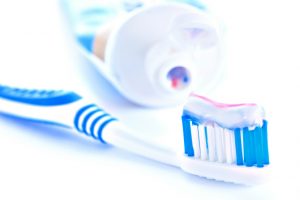There are a lot of common myths surrounding fluoride which leads to some confusion as dentists prescribe fluoride all the time. So what’s the deal? In this first instalment, we’ll be looking at what fluoride is and how it helps our teeth.

What is Fluoride and What Does It Do?
Fluoride is a naturally occurring mineral found in your teeth and bones. It’s also found naturally found in water, soil, plants, rocks, even the air.
When you eat sugar and carbohydrates, bacteria is used to break these substances down. But as a result, the acids these bacteria use to break down sugars is the same acid that eats away at the minerals in your tooth enamel (i.e. demineralisation). The less minerals there are in your teeth, the weaker and more susceptible your teeth are to decay and cavities.
In dentistry, we use fluoride to:
- strengthen your tooth enamel (by remineralising/rebuilding it as well as slow down any mineral loss)
- prevent and even reverse (early signs of) tooth decay
- prevent the growth of harmful bacteria in your mouth

What is Fluoride Used In?
In dental products, you can find fluoride in:
- toothpaste
- floss
- mouthwash
- tooth mousse/gel/foam
- dental sticks
- dental varnish
- oral supplements
However, fluoride can also be used in other areas not dental-related. It is used in much higher concentrations in:
- medical imaging scans (e.g. PET scans)
- cleaning agents and solutions
- pesticides
- making Teflon, steel, and aluminum products

Are There Any Side Effects?
Fluoride is naturally occurring so in its normal, natural doses, there are no ill side effects. However, if fluoride is consumed in large quantities, there can be issues.
Dental Fluorosis
This only really applies to children under the age of eight. If kids consume too much fluoride while their teeth are still forming under their gums, they’ll develop dental fluorosis. White spots form on the surface of their teeth when their teeth finally erupt. But the ill side effect is cosmetic alone – apart from the appearance, fluoride causes no other symptoms when dental fluorosis is concerned.
The reason why kids tend to be susceptible is because they are more likely to swallow toothpaste once they finish brushing their teeth. If the toothpaste has fluoride, they’re ingesting fluoride in large quantities. You can combat the risk of your child developing dental fluorosis by supervising them while they brush their teeth and encouraging them to spit out the toothpaste once they’ve finished brushing.

Skeletal Fluorosis
As you’ve probably guessed, skeletal fluorosis is just fluorosis of your bones instead of just your teeth. The symptoms of skeletal fluorosis manifest in joint pain and stiffness; over a long period of time, it can even alter bone structure and cause calcification of ligaments.
The cause of skeletal fluorosis is long-term exposure to high levels of fluoride. But adults tend to not swallow their fluoride toothpaste so what’s going on?
Excessive amounts of fluoride in drinking water have occurred in the past when an accident has happened (e.g. fires/explosions resulting in accidental contamination of a water source) or when large geologic deposits of fluoride have contaminated the water (as seen in certain parts of Africa or Asia). In developed, first-world countries though, skeletal fluorosis is very rare.

This leads to the controversial part of the fluoride discussion: is fluoridated drinking water safe or dangerous for people’s health? We will tackle this topic in more depth in next week’s blog.
